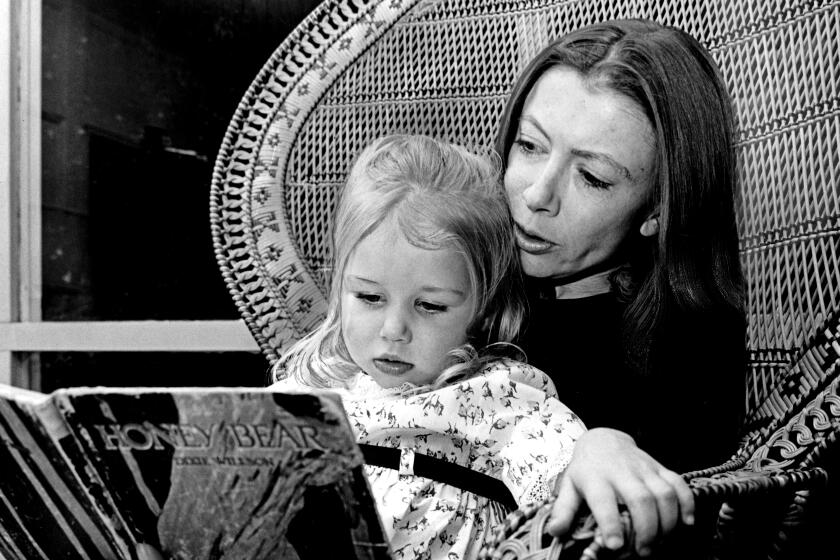Struggles On and Off the Court : DAYS OF GRACE: A Memoir, <i> By Arthur Ashe with Arnold Rampersad (Alfred A. Knopf: $24; 320 pp.)</i>
- Share via
There is a haunting, lonely quality to a posthumous autobiography, an angelic remnant of both an individual and a member of a community. That’s particularly compelling in the case of Arthur Ashe, who began working on this book with Arnold Rampersad (Langston Hughes’ biographer) weeks after he’d publicly announced that he had AIDS; he finished proofreading the final galleys two days before his death this past February at age 49.
What Ashe calls “A Memoir” reveals a man who embodied many delightful and contradictory impulses. He was a world-class tennis player who characterized his on-court style as “adventurous, sometimes even reckless,” while never showing his feelings in a highly ego-driven sport. Yet Ashe also displayed a powerful penchant for sensitivity and perspective, as when discussing the series of circumstances that not only kept him in the public eye, but also wore down his body: “If I don’t ask ‘Why me?’ after my victories, I cannot ask ‘Why me?’ after my setbacks and tragedies.”
Right from the title--”Days of Grace”--Ashe’s belief in humanity’s power amid challenging circumstances shines. Raised in the “iron-clad grip of legal segregation” governing Virginia of the ‘40s and ‘50s, Ashe lost his mother at age 6, took up tennis as “my rod and staff,” tenaciously broke through a lily-white sport’s restrictions and became the first and only male African-American to date to win one of the game’s Grand Slam titles when, at 25, he won the U.S. Open in the highly politicized year of 1968.
Yet until late in his career, his tennis resume had a quality of early promise unfulfilled and a mind scattered on broader issues than his tennis, an openness to ideas he sought and damned: “I had always been an avid reader, but the life of a professional athlete is not always conducive to much reflection. Athletes should be smart, but thinking too much can be a handicap on the court or on the field. So, too, with feeling too much.” But just when Ashe appeared to be in his twilight, he won Wimbledon, ousting the supposedly invincible Jimmy Connors. Though in this book Ashe pays little heed to that accomplishment (“How creative was winning Wimbledon?”), the truth was that he had played the most innovative match of his career and one of the more influential matches in tennis history.
Yet as Ashe describes life and intellectual urges, it appears as if some divine force was seeking to pull Ashe off the court into the broader arenas he had often pined for. At 36, he suffered his first heart attack, ending his career, beginning his post-tennis life as “a professional patient,” and launching his quest for a bigger impact.
How one makes that impact--the topics, the style, the manner and the message--is at the essence of Ashe’s quest. Watching TV during the ’92 L.A. riots, all he could think was, “That’s not us. That’s not us.” With calm dignity and his abiding belief in humanism, over the last decade of his life Ashe began expanding in ever-widening circles.
When teaching a class on African-Americans and sports, Ashe was disturbed to find there was no suitable text on the subject. The result: his own three-volume history, funded by $300,000 directly out of his pocket. His expertise in this area also brought him into debates about athletes, test scores and college education. At a time when many black sports leaders were protesting the infamous Proposition 48 (which mandated an athlete have a minimum SAT score of 700 in order to retain eligibility) as racist, Ashe argued that setting the standard so low was “ridiculous,” and that by so fighting that minimum many were actually underselling the potential of black youth.
A humanist and a champion in a solitary sport, Ashe clung to his belief that individuals--for all the bad that had happened to them--could still take a measure of control of their destiny: “At some point, each individual is responsible for his or her fate. At some point, one cannot blame history. Does the legacy of slavery explain why Mr. Jones eased into class 10 minutes late this morning?”
In 1982 he was asked to join the board of directors of insurance giant Aetna Life & Casualty, providing insights into company policy, management and programs.
As early as 1973 Ashe had made a breakthrough visit to South Africa, grateful that he “could be a rallying point” for struggling South Africans. By the ‘80s he was actively engaged in the anti-apartheid movement.
Yet through all of this external engagement Ashe maintained an inner dialogue. For all his liberalism, the bulk of his life had been in comfortable tennis environs rather than protest lines, leading him to wonder, “To what extent was I trying to make up, with my anti-apartheid crusade, for relative inaction a decade or more earlier during the civil-rights struggle?”
The tensions and lessons lurking around Ashe as public participant and private thinker all came to a head when “USA Today” sought confirmation that he had AIDS. Ashe bitterly resented the way the media’s “outing” of his condition had invaded his family’s privacy. But instantaneously he took a stand on his terms. The Arthur Ashe AIDS Foundation was formed.
Through it all, Ashe remained very much a man of his times, engaged in the struggles of civil rights, emphatically believing that “race to me is a far more onerous burden than AIDS.” Whether it was joining a picket in support of Haitian refugees in front of the White House, meeting with Bill Clinton or continuing his active set of lectures, travels, writings and readings, Ashe was determined to the end of this life to show that he was more than someone who “transcended” tennis, sport or race, but someone who was ready and able to “descend” right into the trenches of the human struggle.
AIDS had only been another step in his lifelong education: “More than thinking of myself as a spokesperson for racial minorities and the poor in the inner sanctum of this life insurance company, I perhaps more acutely believe that I represent the army of sick in America and around the world. In a way, I also represent all male gays, all hemophiliacs and all intravenous drug users who might become infected with HIV. And perhaps I also represent the dying.”
It’s that spirit of life and death together that makes this book so moving, that quality of a single man highly determined to do things his own way, while simultaneously making himself a friend to so many: “In the end, I am not for black or white, nor even for the United States of America, but for the whole of humanity. I can’t define myself finally as an African American, or an American. I have felt that way since I have known myself, and I hope to die that way.”
You did, Arthur. You did.
More to Read
Sign up for our Book Club newsletter
Get the latest news, events and more from the Los Angeles Times Book Club, and help us get L.A. reading and talking.
You may occasionally receive promotional content from the Los Angeles Times.










